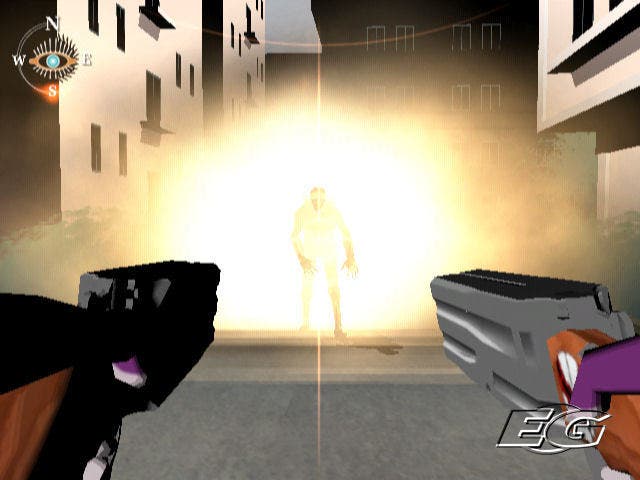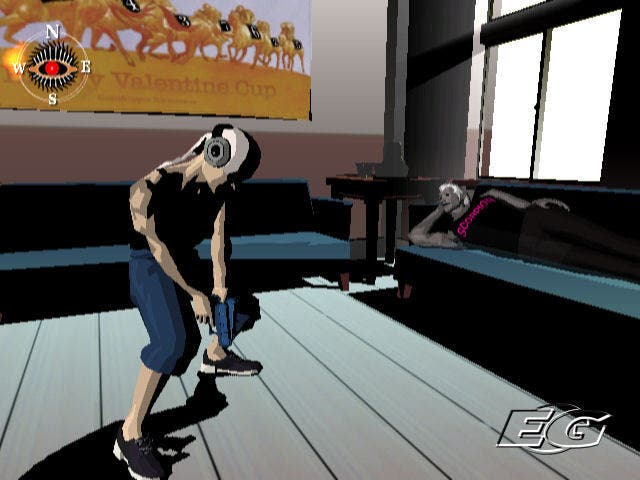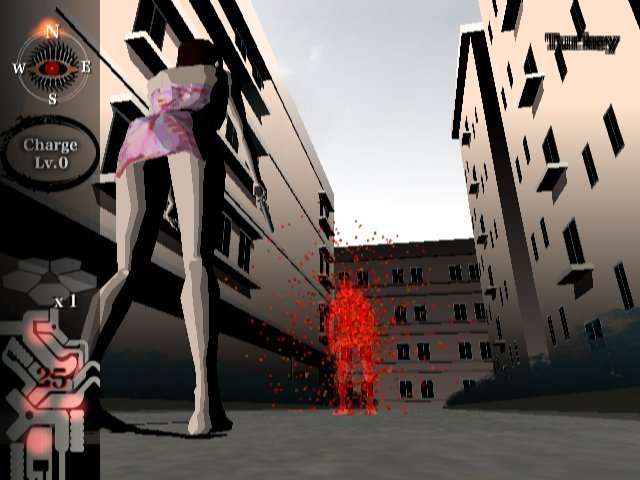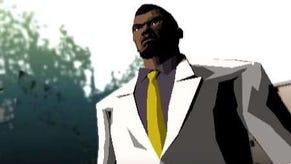Killer 7
Kristan and Tom share the same page, if not the same brain.
Tom's killing in the game of...

Mess. Killer 7 is a mess. A mess of messes, some of which are messy in that comforting "this is my mess" kind of way, and some of which are messy in that depressing "my little brother decided to disassemble my DVD player" kind of way. Critiquing it is very much like trying to reassemble something you didn't take apart in the first place - and the results, as must be obvious from the vastly different reactions charted by various review aggregators and web forums, certainly aren't the same for everyone.
What's slightly disarming about the whole affair is that for all its almost Lynchian obliqueness it actually reveals itself as quite a simple concoction. Movement seems awkward because you're not used to it, but you soon get the hang of running along one path and using the stick to opt for a particular option when it forks, and once you understand about using the left trigger to scan and things like the individual Killer 7 members' reload cycles and various abilities, that side of the game is more of less sewn up, leaving you to apply their standard skills to certain confusing situations and concentrate on not getting your head blown off, solving the relatively simple (and distinctly Resi Evil-esque puzzles) and figuring out what on Earth is going on plot-wise. Once you get the hang of actually playing it, the latter is arguably the most difficult thing in the game.
But to begin with, you will be confused. The omission of a proper tutorial is very daft, with simple concepts like Garcian's ability to resurrect characters barely explained, and critical information hidden away in overlong one-sided chats with apparitions of your past victims who are dotted around the levels to offer advice and the occasional tool. Already confused by the back-to-front mechanics, some people will be turned off by their stumbling verbosity and lose interest - and that opening burst of frustration will sour proceedings and lead to lots of bitching about the movement controls, the aiming, the puzzles, the boss design and so on. Surely this is true of any performance medium? If the audience feels bad about the first bit, they'll greet everything that follows with cynicism until equilibrium is restored.
Killer 7 does that within a few hours, as the core components start to make sense and your characters improve their aiming skill so the crosshair doesn't waver so much, but there are still too many points of division for this to be termed a classic.

The way the movement path is restricted could actually be deemed a good thing if the idea had been put to work a bit more elegantly. Preventing gamers running up against walls and swaggering drunkenly from side to side as they move can upset the suspension of disbelief, not to mention spoil set-pieces. First-person shooters are often guilty of this - as the edginess is scythed away by the player's instinct to constantly back away to frame them on-screen, as if they were a war reporter rather than an actual soldier caught up in the event. Killer 7's movement idea gave the designers the chance to resolve that by framing events and locations creatively, yet most of the levels don't seem to have been designed with that in mind, so the result is something that gets rid of the problem of swaggering characters but fails to visibly improve things by capitalising on the potential it had to go further.
Naturally, in the absence of any obvious improvement, most people instinctively treat it as though it's change for change's sake and, as we've already suggested, if they're pissed off already it's going to earn another red mark on the mental list of things to whinge about on the forum later.
The combat, meanwhile, is going to fracture the groupthink on Killer 7 to an even greater degree. It's a bit like playing House of the Dead with an analogue stick, because it's often impractical to spin round on the spot and back off, and if you just run for it you will collide with enemies who remain translucent until you've scanned them. Standing there fighting, not everybody's good at aiming with analogue sticks. So while some will be perfectly content and find their blood pumped by the slaughter - which is accompanied by some delightfully emphatic victory-babble from your chosen persona, not to mention some extremely arty animations - others will be turned off by it, and may not even stick around to discover that you can make things easier on yourself.

What's more, the game doesn't help itself with monsters that you can't place until it's too late (oh how we yearned for surround sound!), and some encounters that demand pixel-perfect aiming. One sticks in the mind in particular - somewhat aptly, it's an encounter that involves targeting an exposed brain that's just a few pixels wide. Using Kaede's scope, this is tough but doable. But she's only available if you've woken her up by killing a certain number of enemies and using one of the TV sets we mentioned earlier to rouse her. Otherwise you're stuck with two guys with wavering guns and a knife-chucker. It wasn't that hard to stay alive, but even sat two feet from a 36" widescreen TV using RGB cabling it took nearly a quarter of an hour for this writer to register even one hit. Lord knows how anyone's expected to do it that way on a smaller TV using a blurrier connection like composite or RF.
Fortunately, whether you fall on the side of the frustrated or the skilfully enthralled, there are still plenty of things that will appeal to any gamer in the short and long term. The visuals are the most obvious hook - a dazzling arrangement of coloured cels with only minimal texturing and deliberately peculiar colouring, it's a bit like playing a cel-shaded game with no outlines and only the most striking shadows given more than a gentle gradient-fill of shading. Seeing it in motion for a while, it becomes normal, but it's never short of an artistic flourish to keep you interested - and we're still yet to become bored of the way your character is suddenly tugged apart into floating blobs of blood, which draw to a halt in mid-air and then drop to the floor as one, whenever you switch to another of Harman Smith's personas.

But perhaps the thing that will make or break the jaded gamer's appreciation of Killer 7 is your interest in its narrative. Those of us still content to romp home relying on mere mechanics for entertainment will have made our minds up by now, and there's a good-length adventure here which journeys through plenty of interesting locations and has been designed efficiently with only a few true moments of obtuseness (respawning enemies and remember-the-pattern-and-apply-it-later puzzles, for example) to upset proceedings. But those who need the added padding of a gripping narrative are going to be split between those who enjoy the awkwardly told tale of a planet tumbling into anarchy in the aftermath of World Peace, and those who get bored of the clunky dialogue and the confusingly weighty atmosphere that pervades most of the game's cut-scenes. Sometimes you feel like the only guy in the room who doesn't know what's going on, and if you're the sort of person who finds that off-putting rather than intriguing, you might not last.
Still, if Killer 7 is undisputedly one thing then it's fascinating. It's absolutely fantastic to see something like this given a worldwide release on PS2 and GameCube in such a risk-averse climate, and Capcom deserves kudos for giving the game its support. Whether it deserves kudos for the content is a much more difficult equation to unravel, but for all its divisiveness and peculiarity, it seems obvious which number belongs on the end.



